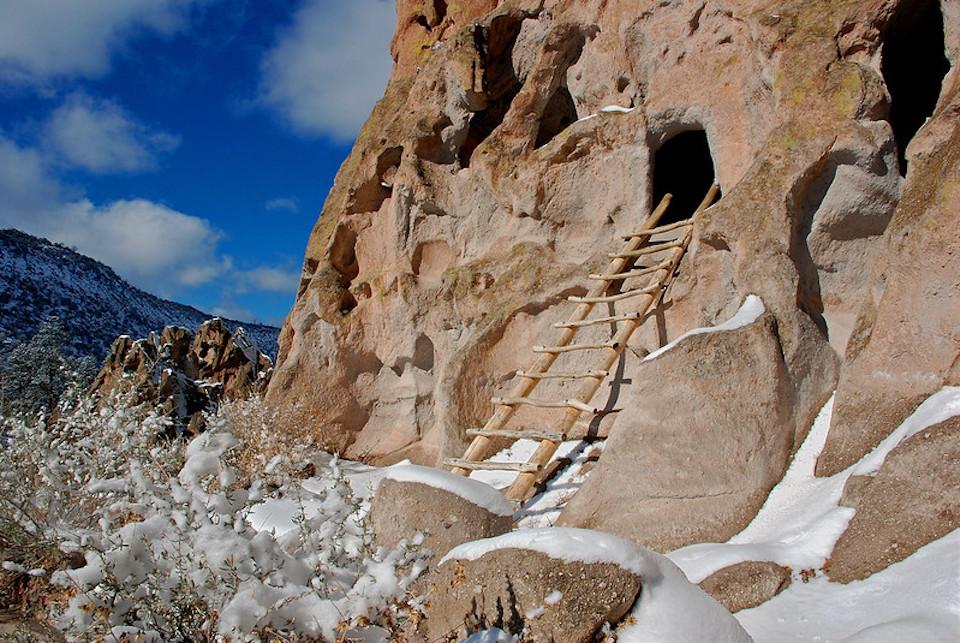
A group has voiced its opposition to proposed legislation that would redesignate Bandelier National Monument as a "national park/NPS file, Sally King
In a move that could be compared to swimming against the tide, an advocacy group in New Mexico is urging the state's U.S. senators not to push for rebranding of Bandelier National Monument as a "national park."
There have been a number of rebranding moves across the National Park System in recent years, turning Pinnacles National Monument, White Sands National Monument, the Jefferson National Expansion Memorial, and Indiana Dunes National Lakeshore into "national parks." A similar effort has been voiced for New River Gorge National River.
But the board of directors of Caldera Action, a nonprofit organization focused on protection, access, and education on National Park Service lands in the Jemez Mountains and associated public lands, this week voted unanimously to oppose a bill introduced in the Senate that would change Bandelier's designation.
Bandelier protects more than 33,000 acres of rugged but beautiful canyon and mesa country in northern New Mexico, as well as evidence of a human presence on the landscape going back over 11,000 years
A letter (attached below) sent Wednesday by the Caldera Action board to the senators argued that the national monument cannot bear additional crowds the rebranding would bring due to "inadequate and crumbling infrastructure and inadequate staffing."
The board also said the legislation would "open 4,300 acres of land within the monument that is fully protected now to hunting and trapping, taking wildlife management away from the National Park Service and giving it to the New Mexico Fish and Game Department."
"Currently, Bandelier lands are a refuge for a wide range of wildlife including beaver, bobcats, cougar, and other animals that face threats on most lands in the Jemez Mountains. We are opposed to all trapping on National Park Service lands in the Jemez Mountains," the letter read.
Caldera Action is calling on Congress to address severe funding shortfalls for the National Park Service at Bandelier and nationally before promoting National Park Service properties as economic development tourist attractions. Decaying and inadequate infrastructure, deficient staffing, staff housing shortages, and the delicacy of the cultural and natural features that attract the public, all argue for leaving Bandelier a National Monument, the group said.
The Senate bill directs the National Park Service to facilitate tribal cultural practices within the monument and to consult with tribes on National Park Service management actions. Bandelier staff has facilitated tribal cultural activities at Bandelier for decades and it already carries out detailed consultations with tribes over all substantial management actions at Bandelier.
The group maintained that rebranding Bandelier does not serve the interests of the American people, the National Park Service, or the natural and cultural resources of Bandelier National Monument.
Bandelier was designated a national monument under the Antiquities Act in 1916 to protect the significant cultural features of the area. Plundering of cultural artifacts in the Bandelier area helped inspire the passage of the Antiquities Act in 1906. Bandelier National Monument encompasses 33,677 acres of rugged volcanic plateau land. The monument adjoins the Valles Caldera National Preserve (also managed by the National Park Service) to the west, Los Alamos National Laboratory to the north, and a mix of tribal and National Forest lands on other boundaries.



Comments
Carlos, I respectfully disagree that Trade Unions would oppose a new CCC. The Davis Bacon Act would also not apply to a Civilian Conservation Corps enrollee. The first director of the CCC was Robert Fechner, who was the VP of the International Association of Machinists, a major trade union. The CCC enrollees made a dollar a day and this was perceived to be a threat to union jobs. What Fechner and FDR did was brilliant and defused this concern. They hired thousands of LEM or local experienced men, who taught the enrollees how to be stone masons, carpenters, mule skinners, and so forth. The LEM were paid good wages and union and non-union workers were employed to provide the material needed to employ 300,000 young men aged 18-25, and 25,000 veterans. We don't have the same dire economic situation we had in the thirties. But we do have the need to rebuild our infrastucture in our public lands and elsewhere. We have a national discussion going on now about paying for tuition at public universities and trade programs. Why not have a one year national service program for those wanting a free tuition? I had the GI Bill that paid for much of my college tuition. I became a Forester with the US Forest Service and started work as a crew leader of young people in the summer of 1971 with the Youth Conservation Corps. The experience I remember the best was being trained by a veteran of the CCC. Finally, I cannot imagine anyone in the NPS, USFS, BLM, USFWS, or BIA that would be opposed to a 21st Century Civilian Conservation Corps. Many states have similar programs and we have the Job Corps programs, many of them with a focus on conservation.
Baehr---Use of the term "Deep State" is an indicator. FWIW, it is not a good indicator,
The NPS has a vested interest in maximizing usage mostly because of the policy of not limiting usage. If you look at places like Yellostone NP America is loving this place to death. It is over crowded at peak season. This is causing degradation of the natural environment the NP system looks to save.
A limited entry system has worked in other parks like Denali NP. Why can't this type of system be applied across the whole NP system?